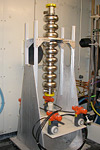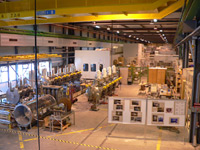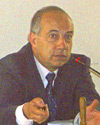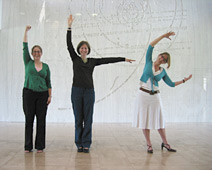 |
|
|
 |
First US Processed ILC Cavity Achieves Milestone

Last week US facilities reached a milestone in testing superconducting cavities for the ILC. |
Last week, after undergoing a buffered chemical polishing (BCP) treatment at Cornell University, the first US purchased, processed and tested International Linear Collider superconducting cavity achieved a milestone accelerating gradient of 26 MV/m (megavolts per meter). A joint effort of the SMTF (Superconducting Module Test Facility) collaboration, this accomplishment was a first test for the US facilities for ILC.
"This is a good achievement for the first step that we are going to take," said Hasan Padamsee of Cornell University. "ILC cavities have not been tested in the US yet, and none of our facilities have been checked out to that extent. We decided to do a standard treatment that has been done for some years now, and we got the best result that you can hope to get at this stage."
An etching process to essentially clean the cavity, the BCP treatment removes the damaged layer – typically 100 micrometers thick. Subsequently there is high pressure water rinsing to thoroughly scrub the surface clean. In addition to surpassing the desired gradient goal for this first BCP stage, which is 25 MV/m, the cavity showed no field emission. "Field emission is what you get when there is dirt on the cavity," Padamsee said. "We showed no field emission, which means that our process is very clean."
Purchased from the ACCEL Instruments in Germany (see ILC NewsLine, 20 October 2005), the cavity underwent mechanical measuring and testing at Fermilab before being sent to the SMTF collaboration partners Cornell and JLab. At Cornell, Curtis Crawford played a key role in all the preparation and testing operations.
Read more...
-- Elizabeth Clements |
 |
|
|
 |
|
 |
 |
|
|
 |
Key options for FP7: a superconducting RF facility at CERN?

'SM18' at CERN: This is where the proposed test facility could be installed when LHC tests are finished. |
For the ILC, superconducting radiofrequency cavities will have to be produced at unprecedented scale. More than 15000 cavities with a reliably high gradient will be needed – and a facility where they can be tested and prepared. At a meeting at the French Linear Accelerator Lab LAL in Orsay last week, the European SCRF elite got their heads together and came up with a proposal: to build such a facility at CERN.
"It would be an ideal-case scenario," explains Eckhard Elsen from DESY, EUROTeV coordinator. Even though a test facility exists at DESY for the XFEL, it would have to be extended massively to accommodate the planned facility if it were to serve the needs of the ILC and possibly other users. At CERN SC infrastructures will become available with the start-up of the LHC. And although the test halls would have to be remodelled, the cost would be lower than building such a facility from scratch somewhere else. The proposal was presented to the European Steering Group on Accelerator R&D (ESGARD) on Friday, and the scientists have started drafting a proposal for the upcoming FP7, the European Commission's funding programme for research for the years 2007 - 2013.
Read more...
-- Barbara Warmbein |
 |
|
|
 |
The First International School for Linear Colliders Held

The first International School for Linear Colliders was held last week in Japan. |
On 19-27 May 2006, the first International School for Linear Colliders took place at Sokendai, Graduate School for Advanced Studies in Hayama, Japan. "It was the first truly international school that focused on the specific subject of the International Linear Collider (ILC)", said Weiren Chou (FNAL), chair of the school's Curriculum Committee and chair of the ICFA Beam Dynamics Panel. This school was jointly organised by the GDE, International Linear Collider Steering Committee (ILCSC) and the ICFA Beam Dynamics Panel.
"I enjoyed the school very much", said Lee Hammons, of Brookhaven National Laboratory and State University of New York Stony Brook. The organisers received a lot of positive feedback from the participants, demonstrating the success of the school. "It was a very interesting experience", said Nicolas Delerue of the University of Oxford.
Read more...
-- Nobuko Kobayashi, KEK |
 |
|
|
 |
From Science Magazine
26 May 2006
A Quiet Leader Unites Researchers in Drive for the Next Big Machine
Three years ago, particle physics was, like Julius Caesar's Gaul, divided into three parts. Physicists around the world agreed that they should build an International Linear Collider (ILC), a 30-kilometer-long particle smasher that would blast electrons into their antimatter partners, positrons, to produce new particles and probe a new high-energy frontier.
Read more...
(member access required)
|
|
 |
 |
|
|
 |
FALC Grapples with its Governance

Roberto Petronzio chairing the FALC meeting at INFN Headquarters in Rome on 22-May-06 |
Last week I attended the meeting of the Funding Agencies for the Linear Collider (FALC) at the INFN Headquarters in a historic building nestled in the small twisty streets near the Pantheon and Piazza Navona in the heart of beautiful old Rome. This was the eighth meeting of the funding agencies – and perhaps the most important, at least in some ways.
Perhaps the most interesting discussions involved the governance structure of FALC. In particular, the funding agencies realised that in order to make progress towards a construction decision for the linear collider, FALC will have to consider the wider picture of particle physics research. For this reason, the scope of FALC was proposed to be broadened to monitor and exchange information on the major particle physics R&D programmes, including LHC upgrades, the ILC, CLIC, and a worldwide neutrino programme. By widening the focus, FALC hopes to be better able to find a path to the ILC that takes all these other factors into account. One might be concerned that this new larger scope could dilute the FALC efforts for the ILC - but that is certainly not the intent.
In terms of a tangible outcome of this FALC meeting, the Memorandum of Understanding for the GDE common fund was approved. This now paves the way for the small central office of the GDE to receive shared funding from the participating agencies in the different parts of the world for its operations. Up until now, the funding has come from the US DOE. Although the amount is modest (~$375K/year), it represents the first formal agreement of the funding agencies to provide shared funding for our efforts. The actual arrangement does not set a precedent for how the funding will be shared in the future, but it does set a precedent for how to create future central funding. The approved common funds are to support our GDE administrative work, ILC communications, web support, supplies and travel funds.
--Barry Barish
Director's Corner Archive |
 |
|
|
 |
|

Three cheers for the ILC!
|
|
ILC Related Preprints
hep-ph/0605298
27 May 2006
Probing CP-violating contact interactions in e+e- --> HZ with polarized beams
hep-ph/0605306
27 May 2006
Gravitino Dark Matter and Cosmological Constraints
hep-ph/0605288
26 May 2006
Higgs Phenomenology with CPsuperH
hep-ph/0605272
25 May 2006
Reconciling large CP-violating phases with bounds on the electric dipole moments in the MSSM
hep-ph/0605257
24 May 2006
Detecting metastable staus and gravitinos at the ILC |
|

